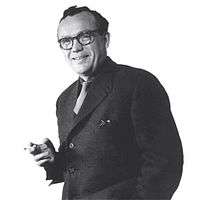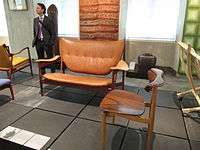Finn Juhl
Finn Juhl (30 January 1912 – 17 May 1989) was a Danish architect, interior and industrial designer, most known for his furniture design. He was one of the leading figures in the creation of Danish design in the 1940s and he was the designer who introduced Danish modern to America.
Finn Juhl | |
|---|---|
 | |
| Born | 30 January 1912 |
| Died | 17 May 1989 (aged 77) Ordrup, Denmark |
| Nationality | Danish |
| Occupation | Architect |
| Awards | 1978 Honorary Royal Designer for Industry, London |
| Projects | Pelican chair (1940) Westermann's Fireside chair (1946) Egyptian chair (1949) Chieftain chair (1949) Japan chair (1953) Bwana chair (1962) |
Early life and education
Finn Juhl was born on 30 January 1912 to an authoritarian father who was a textile wholesaler representing several English, Scottish and Swiss textile manufacturers in Denmark, and a mother who died shortly after he was born. From an early age he wanted to become an art historian, already as a teenager spending much time at the Statens Museum for Kunst and in spite of his young age receiving permission to borrow books at the Ny Carlsberg Glyptotek, but his father convinced him instead to pursue a career in architecture.[1] He was admitted to the Architecture School at the Royal Danish Academy of Fine Arts where from 1930 to 1934 he studied under Kay Fisker, a leading architect of his day and noted lecturer.
After graduating, Juhl worked for ten years at Vilhelm Lauritzen's architectural firm, where he had also apprenticed as a student. In close collaboration with Viggo Boesen, Juhl was responsible for much of the interior design of the national broadcaster Danmarks Radio's Radiohuset, one of the firm's most high-profile assignments during those years.[2] In 1943 he received the C.F. Hansen prize for young architects.
Furniture and other product design

In 1945 he left Vilhelm Lauritzen Architects and set up his own design practice, in Nyhavn in Copenhagen, specializing in interior and furniture design. However, his work in furniture design began earlier than that.
Juhl made his debut in 1937 when he commenced a collaboration with cabinetmaker Niels Vodder which would continue until 1959 and exhibited at the Cabinetmakers' Guild Exhibitions, the 11th of its kind. Therefore, his early chairs were originally produced in small numbers, eighty at most, because the Guild shows emphasized the work of the artisan over the burgeoning industry of mass production. However, they were almost all reissued later in his career.[3]
The Guild Exhibitions were an important venue for the young designers who sought to renew Danish design, turning their backs on the traditional historicist styles, heavy and with ornaments and plush, instead creating modern furniture which fitted the new trends in architecture. The projects was highly controversial and Juhl's first work met much criticism. His Pelican chair, designed in 1939 and first produced in 1940, was described as a "tired walrus" and "aesthetics in the worst possible sense of the word".[4] In spite of the initial criticism, Juhl's work began to influence the style of homes abroad throughout the 1940s. In Denmark, however, his popularity did not reach that of his peers, Børge Mogensen and Hans Wegner, who were less radical in their designs and relied more on Kaare Klint, leader of the furniture school at the Academy and the Nestor of modern Danish furniture design.[4]
In 1948 Edgar Kaufmann, Jr., leader of the Department for Industrial Design at Merchandise Mart in New York, toured Scandinavia. He intentionally did not visit only the big Scandinavian exhibitions, but being impressed by Juhl's work he presented it in a large article in the Interiors magazine. In 1951 he participated in the Good Design exhibition in Chicago. In connection with the show he was quoted in Interiors for stating that "One cannot create happiness with beautiful objects, but one can spoil quite a lot of happiness with bad ones". The work he did for them, 24 pieces including chairs, tables, storage units, sideboards and desks, represented his first successful marriage of modern mass production to his traditionally high craft standards.
At the Milan Triennial in the 1950s, he won a total of five gold medals, further adding to his international reputation. During this decade he continued to design more specifically for the mass market than had been the case in the 1940s.
Juhl also designed refrigerators for General Electric, glassware, ceramics, a line of furniture for the Baker Furniture Company of Holland, Michigan, and was the interior designer for the United Nations Trusteeship Council Chamber in New York City.
In the 1960s and '70s he experienced a declining interest in his designs but in the 1980s and '90s, interest resurged. In 2000 Juhl's partner Hanne Wilhelm Hansen passed the rights to his designs to the company Onecollection. In 2010 one of his sofas, the 57 Sofa, relaunched by Onecollection, won a Wallpaper Design Award in the Best reissue/sofa design category.[5] Onecollection has changed its brand name to House of Finn Juhl and the company has a collection of more than 40 relaunched pieces of Juhl's designs.
Interior design
His work also included numerous assignments within the field of interior design. Shortly after opening his own office, he received several commissions to do interior design at some of the premier addresses in Copenhagen, Bing & Grøndahl's shop on Amagertorv (1946), now housing Royal Copenhagen, and Svend Schaumann's florist's shop on Kongens Nytorv (1948). In 1951–52 he designed the Trusteeship Council Chamber in the Headquarters of the United Nations in New York City. He also collaborated regularly with companies such as Georg Jensen and Scandinavian Airlines, his work for the latter including both ticket offices and interiors of planes. He also had many assignments as an exhibition designer.
Private life
In 1942 Juhl designed a house for himself, today known simply as Finn Juhl's House, and had it built with money inherited from his father. Over the years it was increasingly furnished with creations of his own design.
He married Inge-Marie Skaarups on 15 July 1937 but they divorced. From 1961 he lived in a common-law marriage with Hanne Wilhelm Hansen,[6] a member of the family behind the Edition Wilhelm Hansen music publishing house. After her death in May 2003, their home, which she had left unchanged after his death, was made into a historic house museum, today operated as part of the Ordrupgaard Art Museum whose premises it adjoins.[7]
Academia
Juhl was a teacher at the Danmarks Designskole in Copenhagen from 1945 to 1955. In 1965 he was a visiting professor at the Institute of Design in Chicago.[6]
Style and legacy
Juhl gave a soft edge to the lines of wooden modernist chairs, favouring organic shapes which often took the wood to the limits of what was possible. He generally used teak and other dark woods, unlike many of the other proponents of the Danish Modern movement who often used oak in their designs.[4]
He was influenced by the abstract sculptor Jean Arp, an influence which is seen already in his early Pelican chair but it remained a motif throughout his career. Also influenced by tribal art, Juhl exhibited the Chieftain chair with photos of weapons from anthropological studies.
One of his hallmarks was the floating back and seat which is seen in most of his chair designs, usually upholstered, in contrast to the hard wood of the bearing elements. The full back and seat, seeming to hover on their supports, start to emerge in the chairs from 1945 and 1948.
Selected works
Furniture
- Pelican chair (1940)
- FJ41 aka Poet sofa (1941)
- NV44 chair (1944)
- NV45 chair (1945)
- FJ46 chair (1946)
- BO64 chair (1946)
- Westermann's Fireside chair aka BO59 (1946)
- FJ48 chair (1948)
- Egyptian chair (1949)
- Chieftain chair aka FJ49A (1949)
- Judas table (1946)
- Baker sofa (1951)
- BO98 chair (1952)
- Japan chair aka FD137 (1953)
- FJ53 chair (1953)
- BO101 chair (1953)
- FJ55 chair (1955)
- FD136 chair (1958)
- BO62 chair (1962)
- Bwana chair aka FD152 (1962)
Interior designs
- Bing & Grøndahl shop, Amagertorv, Copenhagen (1946)
- Svend Schaumann's florist's shop, Kongens Nytorv (1948)
- Trusteeship Council Chamber, U.N. Headquarters, New York (1951–52)
- Georg Jensen store, Fifth Avenue, New York (1952)
- Designed a room with his own furniture, etc. at the Nordenfjeldske Museum of Applied Art, Trondheim (1952)
- Georg Jensen silversmithy, 50th anniversary exhibition, Museum of Decorative Art, Copenhagen, 1954.
- Fifty Years of Danish Silver exhibition, London, [1954]; in Washington, Louisville and Dallas (1955); St. Louis (1957)
- Denmark's stand, Milan Triennial X, Italy (1954)
- Director's office for France & Daverkosen, Ørholm, (1955)
- Model apartment, H55 exhibition. Helsingborg, Sweden, (1955)
- 30 SAS ticket offices in Europe and Asia (1956–61)
- Georg Jensen shop, Toronto, Ontario, Canada (1956)
- Interior design of DC-8 planes for SAS
- Georg Jensen shop, New Bond Street, London (1957)
- Denmark's stand, Milan Triennial XI (1957)
- Furnished the ambassador's residence, Embassy of Denmark in Washington, D.C. (1960)
- Arts of Denmark, Metropolitan Museum of Art, New York (1960)
- The Arts of Denmark exhibition moved to museums in Washington D. C., Chicago, and Los Angeles, 1960-61.
- Bing & Grøndahl shop expansion, Amagertorv, Copenhagen (1963)
- Wilhelm Hansen Musikforlag shop, Gothersgade, Copenhagen (1966)
Buildings
- Finn Juhl's House, Klampenborg, Denmark
- Mrs Anthon Petersen's summer house in Asserbo, Halsnæs Municipality, Denmark, 1950.
- Single-family house for M. Aubertin, Nakskov, Denmark, 1952
- Georg Jensen shop, Toronto, Ontario, Canada (1956)
- Summer house for Anders Hostrup-Pedersen (managing director of Georg Jensen), Rågeleje, Denmark (1962)
Awards and distinctions
- 1943 C. F. Hansen prize for young architects
- 1947 Eckersberg Medal, Denmark
- 1954 Honorary Diploma, Milan Triennial X, Italy
- 1957 three gold medals at the Milan Triennial XI
- 1960 Kaufmann International Design Award
- 1964 A.I.D. prize for design, Chicago
- 1978 Honorary Royal Designer for Industry, London
- Knight of the Order of Dannebrog, Copenhagen
- Best reisue/sofa design, 2010 Wallpaper Design Award[5]
Collections
- The Finn Juhl Chair Design Collection, 1950, is held by the Ryerson & Burnham Libraries at the Art Institute of Chicago.
- Three chairs, Museum of Modern Art, New Vork
Exhibitions
- 11th Cabinetmaker's Guild Exhibition, Copenhagen (1938)
- Contemporary Danish Architecture, London (1950´)
- Danish Handcraft Guild exhibition, London, 1950
- Good Design exhibition, Chicago, 1951.
- Angewandte Kunst aus Dänemark exhibition, Zurich (1952)
- Home of the Future exhibition at the Cabinetmakers Guild 400th anniversary exhibition, Forum, Copenhagen, (1954]
- Neue Form aus Dänemark, traveling exhibition in 8 German cities and Vienna (1956–57)
- Two Centuries of Danish Design, Victoria and Albert Museum, London, 1968
- A Century of Danish Design, Kelvingrove Museum, Glasgow, and Whitworth Art Gallery, Manchester (1968)
- Exhibition of arts and crafts, Brussels (1969)
- Finn Juhl retrospective exhibition, Charlottenborg Palace Charlottenborg Autumn Exhibition, Copenhagen (1970)
- Finn Juhl exhibition, Cantu, Italy, 1973.
Bibliography
- Hiort, Esbjoern, Finn Juhl: Architecture-Furniture-Applied Arts. Danish Architecture Press. Copenhagen, 1990. ISBN 87-7407-094-0
- Hansen, Per H., Finn Juhl og hans hus. Gyldendal/Ordrupgaard. Copenhagen 2009.
See also
References
- "History". onecollection. Archived from the original on 2010-05-01. Retrieved 2010-04-19.
- "Finn Juhl". Danish Furniture Design. Retrieved 2010-04-21.
- "Contemporary Design profile: Finn Juhl". Finn Juhl estate. Archived from the original on 2011-07-16. Retrieved 2010-01-04.
- "Fremsynet enegænger sørgede for danske stole i USA". Politiken. Retrieved 2010-04-21.
- "Design Awards 2010: the winners". Wallpaper. Retrieved 2010-04-21.
- "CV". Onecollection. Archived from the original on 2010-02-02. Retrieved 2010-04-21.
- "Besøg den gode smags bolig". Politiken. Retrieved 2010-04-21.
External links
| Wikimedia Commons has media related to Finn Juhl. |